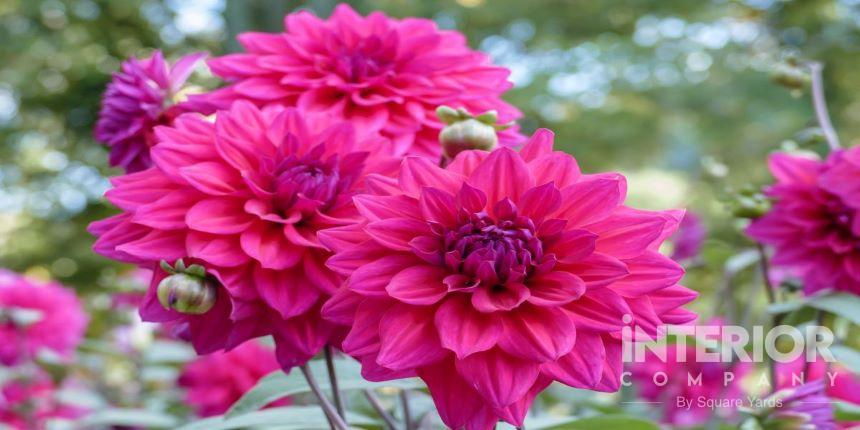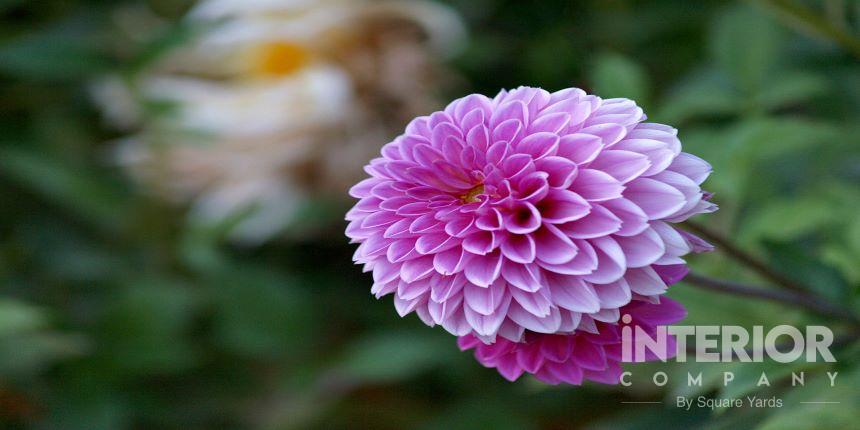Believe me! Its newfound popularity doesn’t show any signs of warning at all and for obvious reasons. This incredible plant has something to offer to everyone. And the most loving aspect of this plant is that it doesn’t have many adjustment tantrums like the others. The plant loves to grow in a sunny and humid atmosphere. Besides, it is easy to care.
But hey, wait a minute! You do need to ponder a few things before you plant Dahlia or it will be dead in no time. Read on to know some amazing and proven tips on how to plant, grow, cut, and take care of the Dahlia plant.
Dahlia Plant: An Overview

Dahlia is a genus of bushy, herbaceous, and perennial plant with tuberous roots. Native to Central America and Mexico, the plant is a member of the Compositae family (also known as Asteraceae) of dicotyledonous plants. Daisy, sunflower, zinnia, and chrysanthemum are a few garden relatives of this beautiful plant.
Being a member of the Asteraceae, the plant consists of a flower head that’s surprisingly a composite having both surrounding ray florets and central florets. Each floret is a flower, however, many horticulturists often incorrectly describe it to be a petal.
Dahlia has a total of 42 species with hybrids popularly grown as garden plants. The flower form varies with one head per stem; its diameter ranges from 5 cm to 30 cm. This amazing variety is the result of the plant being octoploids. It means that the plant comprises eight sets of homologous chromosomes, while most plants have only two.
Although the flower thrives mostly in the sun and humid environments, it is grown as annuals in some regions rendering cold winters. While some consist of herbaceous stems, others have stems that have the potential to lignify in the absence of secondary tissue and resprout following winter dormancy, allowing further seasons of growth.
Now the most important thing to know about this flower is that the majority of its species don’t produce aromatic flowers. Unlike other plants, dahlia pinnata doesn’t attract pollinating insects. So, you won’t have to worry much about insects eating them.
But you do need to know a few things about this impeccable herb in case you are planning to add this beauty to your garden. Read on to know about planting and growth.
A Few Well-Known Species of Dahlia from Asteraceae Family
As described above, Dahlia has a total of 42 species. Some of the popular ones are as follows:
- Dahlia Pinnata
- Dahlia Coccinea
- Black Dahlias Flower
- Star Dahlia or Yellow Star- Plant type: Dahlia Bulb
- Dahlia Imperialis
- Purple Dahlia
- Red Dahlia Flower
- Dahlia Blue
- Bishop Dahlia
- White Dahlia Flower
Dahlia Flower Season: The Best Time to Plant
Dahlias are tropical and tender plants. Therefore, it’s essential to protect them from frost. Due to the same, it’s usually recommended to grow them off undercover in your greens between March and April. Then, when the temperature outside gets reliably warmer, you can plant it outside i.e. around May to early June.
How to Plant & Grow Dahlia Flower?

Dahlias growing fresh from tubers every year don’t have the potential at pushing up through herbaceous plants. Therefore, if you are planning to grow them on a border, we recommend you render them their own bit of space. However, there are some that grow the best in pots. They will be an awesome choice for your patio gardening ideas.
Here are some great tips for how to grow Dahlias in your garden:
- Choose a spot that receives plenty of sunlight, especially when you are planning to leave the tuber in the ground during the winter. Also, ensure that the ground has well-draining soil with a pH value of 6.5 to 7.0. It means that the soil must be slightly acidic.
- In case you have decided to grow the plant in a container, you must use rich compost.
- Now dig a square hole in the ground of about 12 inches deep and wide. Also, do not forget to space out the tubers about 24 inches apart.
- Next, fill back the hole with compost and keep it on the dry side until you see Dahlia seedlings. You can start watering only after you see the sign of growth.
If you want your Dahlia to grow fast, you can also use well-rotted manure around the base of the plant soon after planting it. Besides, you also need to feed the plant every week throughout the growing season. Sometimes you can give it a potash-rich tomato feed and the other day you can feed it a seaweed tonic.
Grow Dahlias in Pots
Many of us like to put plants and flowers at our workplace and over the office desk. On the other hand, some of us love to grow it on the patio, balcony, etc. In such cases, you can grow Dahlias in pots. You can grow them even if you don’t have much space. Dahlia comes in different dwarf varieties that will grow easily in a pot on a sunny patio, or balcony. Large-flowered Dahlia is one of them.
You can also consider Bishop Dahlias as they are fairly compact and compatible with growing in pots and containers. Their beautiful single flowers are enough to attract butterflies and bees. Besides, they have beautiful attractive dark foliage and pretty cut flowers.
How to Cut & Arrange Dahlia?
Before you discover how to cut Dahlia, you must know why cutting is even required. The answer is simple- to get more flowers. The more you cut the more blooms it will produce. Therefore, it’s important that you cut it the right way. Here are some tips on cutting and arranging the flower perfectly:
- When the flower is in its full bloom, it’s the best time to cut it. You can cut the blooms frequently to display indoors. As described above, the more you cut, the more blooms it will produce. Deadhead those that are left so that new blooms can come.
- Cutting dahlia flowers in the morning would be the best time to do so as they are cool in the morning.
- Cut the stems of the plant horizontally across the base of the stalk, exactly above where it intersects leaf nodes and the main stem. While arranging, you can snip the flower stalk down to the proper length.
- Next, fill the container with very hot water and put the ends of the freshly-cut flowers in it for up to an hour before arranging. This way the flowers are more likely to last long in the vase. Afterward, transfer them straight to a vase containing cool waters.
- Now before you arrange them, remove any foliage from the stems. It will avoid the flower to decay in the water.
- To keep the flowers fresh for longer, you must change the water in the vase every next day.
- While arranging, must make sure that all the stems of the flowers have an equal length. Bunch them together with other summer flowers to make a cottage-style bouquet. Or you can also opt for a more contemporary look and keep it simple with single-stem or single-variety arrangements.
How to Care- Some Significant Points to Ponder
Now that you know how to grow and plant Dahlia, it’s equally important to understand how to care about it. Obviously, you won’t like to wait for months to see them bloom. So, it’s important you keep the following in mind:
Watering
Suppose you have sown the seeds. Now you have to wait until the Dahlia seedlings appear. Do not water the plant before seedlings. Dahlias don’t like overwatering and hence, excessive water can cause tubers to rot. After it has grown into a plant, it demands deep watering about 2 to 3 times a week. You can use a sprinkler to water it for at least 30 minutes in a dry and hot climate.
Similar to various large-flower hybrid plants, the big dahlias also require additional care before or after rain. The open blooms usually get filled up with rainwater or receive beats from the wind. This may affect the plant badly. So, you must take care of this.
Pinching, Staking, and Disbudding
When the plant grows out to be 1 foot, pinch 3-4 inches of the growing centre branch. This will encourage the plant to be bushier and to grow stem count and stem length.
In case you want to produce large blooms, you must try disbudding. In the process, you will remove the 2 smaller buds following the central one in the flower cluster. It will let the plant put all of its energy into some but considerably larger flowers.
To bed dahlias, you simply need to pinch out the extending part to stimulate bushiness. Then, deadhead it as the flowers fade. Tweak the centre shoot that lies just above the third set of leaves.
Make sure to insert stakes while planting for the taller dahlias. Then moderately disbranch, tweak, deadhead, and disbud to create a showy display for 3 months or more.
Fertilizing- 5-10-10 or 10-20-20
To grow them better and fast, you will have to feed your Dahlia. Low-nitrogen liquid fertilizer that is somewhat similar to fertilizers we use for vegetables, does wonder for this plant. Remember to fertilize it after sprouting and then every 3 to 4 week weeks from mid-summer until early Autumn.
Also, be cautious while you are fertilizing. Make sure not to over-fertilize the plant, especially with nitrogen, or you have small to almost no blooms, weak tubers or it might rot.
Winter Care
With the first light frost in fall, Dahlia foliage will die. Therefore, people residing in colder regions must dig up the tubers before the first hard freeze and store them indoors.
Dahlias are hardy. You can easily cut them and leave them in the ground to overwinter. Then, cover them with a deep and dry mulch. Furthermore, you should also lift the tuberous roots and store them during the winter.
Storing Dahlia Tubers
To store tubers, you will require a loose, fluffy material such as dry sand, vermiculite, and Styrofoam peanuts. Pack it in either of the materials, then store it in a frost-free and well-ventilated place with a temperature around 7°C (45°F).
Wrapping Up
The bushy and herbaceous Dahlia is a beautiful addition to any vase or bouquet. You can grow Dahlia in a pot, container, or in the ground with rich, well-drained soil having pH 6.5 to 7.0, slightly acidic. It is one of the best garden plants that have an outstanding vase life besides the season-long supply of impeccable blooms from mid-summer right through to the first frosts.
Dahlia flowers thrive in sunny and humid conditions. Therefore, you must place it in a spot that receives direct sunlight and less wind. Moreover, you can pinch and cut it regularly to have fun and for more blooms, of course. With its endless blooms, the plant makes your garden look beautiful. So, plant it carefully and follow the care tips so that you can enjoy continuous blooms.